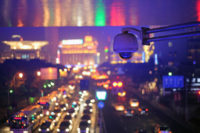As environmental regulations increase, industrialization’s effects stretch further and ecological scientists grasp for new ways to collect vital data, some parties are all reaching for the same thing: business intelligence.
Chris Lane, General Manager and Head of Research and Development for CoastalCOMS, has been enabling enterprises to use business intelligence to collect data and perform detailed analysis on beach erosion in California, as well as to monitor water salinity and root formations in the Logan River in Australia and animal activity in the Daintree Rainforest. CoastalCOMS is an Australian provider of cloud-hosted video and asset management services, which is moving gradually from security to “observation systems,” Lane says.
“These installations are bigger than just video and images,” he says. “We’re combining data from many different sources to make intelligent decisions.”
For example, a hypothetical town in the Australian Outback wants a solar-powered energy system, but cloud cover can come quickly, and it could take up to an hour to power up generators. Algorithms programmed into the digital asset management systems, which can be linked into the New Zealand and Australian atmospheric and meteorological models to predict wind speed and direction up to a day in advance. Surveillance systems monitoring the horizon could detect cloud cover, alerting the system to compute the estimated time of arrival, giving the town’s generators plenty of time to start before the solar panels lose power.
Another hypothetical, Lane says, is in a coal mining town – high winds kick up a lot of coal dust, which is detrimental to workers’ health and the surrounding ecosystem. Air quality sensors around the site notify authorities when a dust cloud gets to a certain level, and the coal port authorities are required to activate a dust suppression system. However, because many of these operations are isolated, it can be difficult to ensure that the protocols have been followed. But by using business intelligence, Lane explains, EPA officials can be alerted when the sensor notes a dangerous air quality level, and they can observe video from the scene of the suppression.
“We’re finding that a log of organizations going from analog to digital systems want an increase in productivity off of the infrastructure that they have,” he says. “They can build fantastic models of what is supposed to happen in the event of an incident, but they still have to verify the reaction through observation.” That’s where triggered surveillance and integrated sensors come into play.
In the Logan River, CoastalCOMS worked with CSIRO (Commonwealth Scientific and Industrial Research Organization) to build monitoring stations stationed on poles in the river. Surveillance cameras look at mangrove roots, crabs and other wildlife, while sensors monitor the salinity levels and effects of flooding on water quality.
At the Daintree Rainforest, James Cook University researchers collect a massive amount of information and live sensor data, monitoring flora, fauna and climate throughout the canopy. By feeding the observation data through a Milestone VMS platform, the researchers can access live sensor monitoring and manual observations in an archive, which can be fused with live video and audio being streamed into the database.
“The tropics are a critical but neglected part of the world – home to two-thirds of the world’s population, half its land mass, up to 80 percent of all species, and also is economically the fastest growing,” says Ian Atkinson, Professor of eResearch at James Cook University in Townsville, Australia. “It is also the region where impacts of climate change are being felt first and possibly with greatest impact.
“JCU has the vision of making the Tropical Data Hub an open data access portal to critical tropical data and knowledge to help solve critical environmental and social issues while promoting economic growth,” he adds.
On the ground level, Atkinson continues, “Like many researchers, we are being overwhelmed by the volumes of digital data generated and available. The CC-DAM (CoastalCOMS Digital Asset Management) is being built into our environmental data collation workflows to automate data collection, processing and indexing so we can not only store data but search for the information within the data.”
Atkinson’s department is using these observation systems to monitor dynamics and change in these environments, which is used to correlate with ecological observations on species changes and behaviors. “This approach lets us better understand rainforest ecology and its response to warming climates and sensitive coastlines adjacent to the Great Barrier Reef which is an ecosystem that is acutely sensitive to pollution and human intervention,” he says.
“When you’re working with high-end products on these big projects,” Lane says, “of course end users are interested in fusing this information together – video, audio and data.”
However, when dealing with so much data, bandwidth becomes a major consideration, especially when sending information to the Cloud.
“Sensory information is so small, data-wise, so when we design these systems, we deal with video first,” Lane explains. “We can control frame rate and bandwidth through the core platform, and then increase resolution for video needed for analysis. We also have the ability to change bandwidth when someone takes control of one of the PTZ cameras.”
“Environmental monitoring, especially now as video & audio systems are more used consume masses of storage,” says Atkinson. “While the data may not be of immediate importance, its value grows in time as better methods are developed to process data and new questions are asked. In addition, experiments and study sites are 'everywhere' – central command and control is not so useful in this model ,and it’s better to move to more cost effective cloud models that let us better focus on science, not infrastructure.”
Some of the camera feeds are streaming live to the public, including some of the surveillance cameras located along Australia’s Gold Coast, a surfing mecca. But, whenever a researcher measuring wave height via camera takes over control of a camera’s bandwidth, the streaming feed to the public is interrupted.
“You have to pick your priority,” Lane says. “Each of these cameras enables three solutions: shoreline and wave analysis; video management; and live streaming.” When you need to start actively observing the feed live, the system automatically forgoes the other options in order to maintain a tolerable level of data use.
This data collection and distribution method allows researchers to develop new plans, either for future research projects, process verification or environmental concerns, and it has helped some California beaches, which have dredging projects every decade to reduce beach erosion, maintain tourism by monitoring and safeguarding wave patterns.
In these projects, and in more to come, business intelligence and security systems are revolutionizing how research is aggregated in remote or hazardous environments (one look at the Death Adder in the Daintree Rainforest might change your mind about manually collecting sensor observations), and these new databases of research can affect the power sources of cities, the health of miners, and natural ecosystems.



